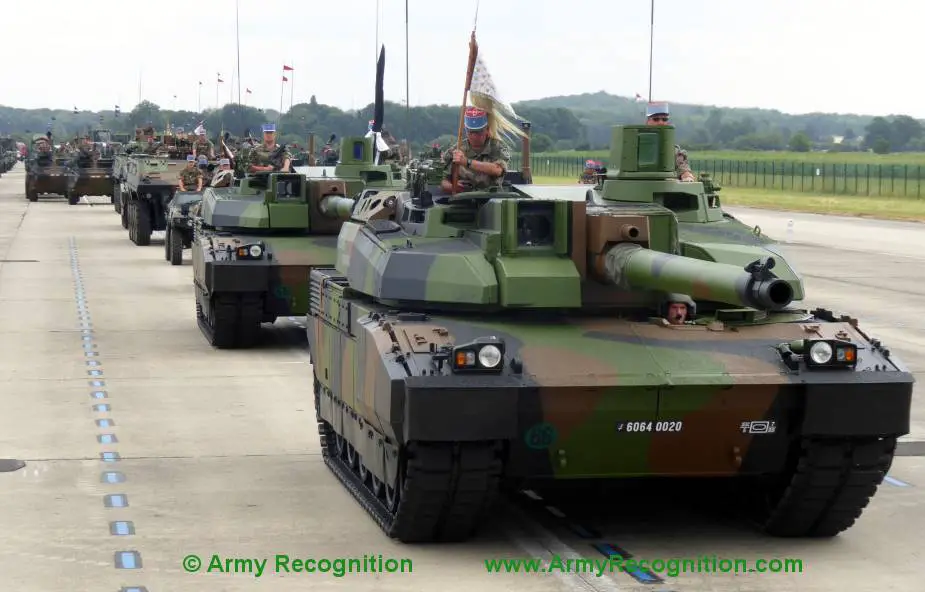Breaking news
France does not rule out delivering Leclerc main battle tanks to Ukraine.
After having planned the delivery of AMX-10RC combat reconnaissance vehicles (erroneously designated as ‘’light tanks’’) within two months, France no longer rules out delivering Leclerc tanks to Ukraine, which would mean, once the British Challenger 2 tanks will have entered the scene, the first time Western-designed tanks will fight against Russian-designed tanks, a crucial test to make their strengths and weaknesses appear in actual combat.
Follow Army Recognition on Google News at this link

French army Leclerc main battle tank (Picture source: Army Recognition)
France does not rule out delivering Leclerc heavy combat tanks to Ukraine in its war against the Russian invader, Emmanuel Macron announced on Sunday, January 22, alongside Chancellor Olaf Scholz, while Kyiv is calling for tanks, in particular to Germany, which holds the key to the delivery of Leopard 2 tanks by several European countries. “As for the Leclercs, I asked the Minister of the Armed Forces to work on them. Nothing is excluded and this is indeed appreciated collectively”, declared the French president, while Mr. Scholz, questioned on the Leopards, declared that “the way in which we have acted in the past is always closely coordinated with our friends and allies and we will continue to act according to the concrete situation”. President Macron added that such a delivery should not cause an escalation of the conflict and actually contribute to efficiently supporting the Ukrainian army, two strange and unrealistic (naive?) conditions. A basic condition is that a donation should not weaken the French self-defense capability. A donation of 15 tanks would mean a squadron, thus not seriously threatening the French army's strength. Regarding the maintenance of a Leclerc, it is interesting to know that it costs around 20,000 EUR per month. The time between two overhauls of its engine is 300 hours, hence the obligation of saving its working time.
Interestingly, the delivery of main battle tanks to Ukraine means a change of scale in arms supply, as tanks are regarded as ‘’offensive’’ weapons, a level higher than infantry fighting vehicles even when armed with a 40mm automatic gun, for instance. When Challenger 2 and Leclerc MBTs will reach the battlefield, it will be the very first time Western tanks will actually fight against Russian-designed tanks, not only in combat simulators.
On its side, Germany will not oppose Poland's desire to deliver Leopard tanks to Ukraine, which is insistently demanding them, if Warsaw asks for permission, Annalena Baerbock, the head of the German diplomacy, said on Sunday, January 22: "If we were asked the question, we would not oppose it," said the minister of the Greens party, which governs in coalition with the Social Democrats of Olaf Scholz and the Liberals about the delivery to Kyiv of these German-made tanks. "For the moment, the question has not been asked" by Poland, required to make an official request to Berlin, said the minister, interviewed in Paris on the French channel LCI. In an interview on German television ARD, the German Defense Minister, Boris Pistorius, said for his part almost at the same time that "the decision (...) depends on many factors and is taken at the chancellery". Poland already declared it would supply some of its Leopard 2 tanks to Ukraine, without Germany's consent if necessary. If Germany gives its green light, it would apparently open the way to all other donations of Leopard 2 tanks to Ukraine.
Why does Ukraine insist on receiving in priority at least 300 Leopard tanks? Because there are some 2,000 of these tanks (1,920, to be accurate) in service with European armies, which means an easy supply of spare parts, ammunition, maintenance equipment, training facilities etc. To summarize, here are the figures about the Leopard 2 tanks of different versions in service in Europe: 52 in Norway, 120 in Sweden 200 in Finland, 247 in Poland, 1 in Slovakia, 353 in Greece, 316 in Turkey, 327 in Spain, 37 in Portugal, 56 in Austria, 134 in Switzerland 1 in Czech Republic, 16 in The Netherlands and 44 in Denmark.




























